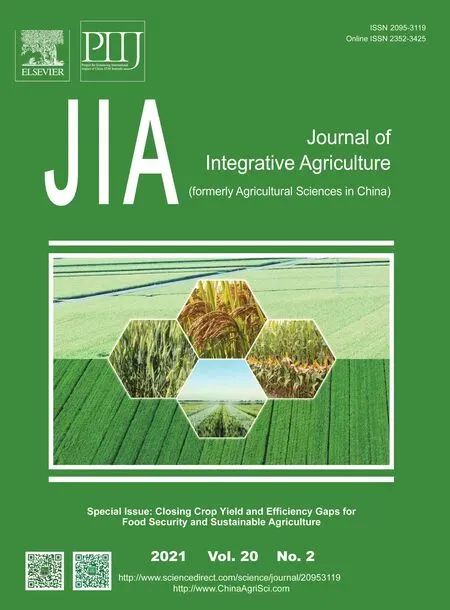lmproving maize grain yield by formulating plant growth regulator strategies in North China
2021-01-18GONGLishaQUShujieHUANGGuanminGUOYulingZHANGMingcaiLlZhaohuZHOUYuyiDUANLiusheng
GONG Li-sha,QU Shu-jie,HUANG Guan-min,GUO Yu-ling,ZHANG Ming-cai,Ll Zhao-hu,ZHOU Yu-yi,DUAN Liu-sheng
1 Engineering Research Center of Plant Growth Regulator,Ministry of Education/College of Agronomy and Biotechnology,China Agricultural University,Beijing 100193,P.R.China
2 Experimental Base Service Center of Agricultural Sciences,Jiyang 251400,P.R.China
Abstract Plant growth regulators (PGRs) are artificially synthesized compounds that have become an important technical guarantee for agricultural production. EDAH (containing 27% ethephon and 3% DA-6) has been proven to inhibit stalk elongation,promote stalk bold and increase mechanical strength and number of vascular bundles. DA-6 could enhance plant photosynthetic capacity and promote cell division and growth. In our study,experiments were performed at summer maize growing season during 2018–2019. The result showed that plant height,ear height and center of gravity height of maize with EDAH+DA-6 treatment were decreased by 10.18,16.77 and 13.21%,respectively; leaf area and leaf area index also significantly (P<0.001) decreased by 24.11 and 60.15%,respectively; the value of mean tilt angle significantly (P<0.001)increased by 16.72% compared with the control plants,which meant that EDAH+DA-6 could shape more compact plant type. Therefore,lodging rate of maize with EDAH+DA-6 treatment decreased by 6.95% compared with control plants,and the grain yield was increased by 15.51%. In addition,EDAH+DA-6 treatment significantly improved the quality of maize base stalks,such as improving mechanical properties,which increased maize base stalk crushing strength by 22.23%;increased the hemicellulose,cellulose and lignin contents by 6.93,3.87 and 30.21%,respectively. In conclusion,EDAH+DA-6 treatment could improve summer maize yield by shaping plant morphological characteristics and group photosynthesis.
Keywords:plant grown regulators,canopy structure,lodging resistance,photosynthetic
1.lntroduction
Maize is one of the most important cereal crops in the world.With the rapid growth of the world population,the demand for food and livestock feed is also increasing (Cassman and Liska 2010). The supply of maize demand usually uses increased planting density to increase maize yield,but it often brings the risk of stalk lodging,which significantly increases the risk and cost of maize production (Songet al.1989; Yanget al.2018). North China Plain (NCP) is the most important summer maize producing area in China.Increasing maize production in the NCP region is of great significance to ensure national food security. However,due to climatic reasons,the summer maize in the NCP region faces a greater risk of lodging.
With the development of modern social economy,agricultural modernization is also speeding development,mechanical grain harvesting methods have been invested in the cultivation of summer maize in NCP,whose process mechanical and chemical control is the development mainstream direction of modern maize production. The use of combined harvesters for direct grain harvesting can not only greatly save labor costs,save farmers’ manual labor,but also reduce mold rot and loss during drying and threshing(Liet al.2016,2018). Lodging is a common phenomenon in maize production,and maize lodging increases the difficulty and cost of straight maize harvesting (Xueet al.2020a).Due to improper selection of varieties,unscientific cultivation techniques and extreme weather,and all other factors will cause maize lodging to vary degrees (Chenet al.2006;Peteret al.2011; Xueet al.2018). According to previous studies on plant morphology,plants with longer stalk nodes at the base of maize have higher plant height,height of center of gravity and ear height,and this type of plants has a higher risk of lodging; on the contrary,shorter and thicker stalks at the base maize plants have strong lodging resistance (Novaceket al.2013; Maet al.2014); mechanical traits of maize stalks such as stalk piercing strength and stalk compressive strength are significantly negatively correlated with maize field lodging rate (Robertsonet al.2014). Maize lodging significantly reduces yield,but lodging occurs at different growing stages will have different effects on yield.The yield loss rates were 9.1,27.5,34.2,and 46.6% of root lodging and stem lodging at the big flare stage,root lodging and stem lodging at the filling stage,respectively (Liet al.2015). Lodging reduced maize grain quality and increased the difficulty of mechanical harvesting (Pellerinet al.1990;Kamaraet al.2003; Tianet al.2016; Xuet al.2019). Thus,solving the problem of lodging is essential for achieving stable and high yields.
The method of spraying plant growth regulators (PGRs) is used to promote the formation of maize biomass,therefore,high-quality maize can be produced. PGRs can optimize plant morphology and increase yield by regulating plant endogenous hormone signal transmission and metabolism(Naeemet al.2012; Zenget al.2012). There have been a lot of studies before that can prove that ethephon can promote the growth of maize aerial roots,reduce ear position and plant height and improve the lodging resistance of maize,but it affects ears development and often shows a reduced yield in the field (Langanet al.1988; Li and Wang 1990;Khosravi and Anderson 1991; Shekoofa and Emam 2007).EDAH (containing 27 ethephon and 3% DA-6) significantly reduced the lodging rate,plant height,ear height,and center of gravity of summer maize,and increased the stalk puncture intensity,dry weight per centimeter,number and area of stalk vascular bundles at the base,and cross-sectional area (Pinget al.1990). Spraying EDAH can effectively improve the lodging resistance of maize,optimize the canopy structure and provide a feasible way to achieve a high yield of maize(Xuet al.2017). It has a positive effect in regulating the activity of maize source and sink,the relationship between root and shoot,grain yield (kernel number per ear) and stem quality. Dong (2006) combined ethephon with DA-6 to study whether DA-6 could make up for ethephon loss of yield,thereby achieving stable yield and high yield while improving the lodging resistance of summer maize (Caiet al.2010).This new plant growth regulator was registered in China in 2006 and was named EDAH. Before and after tasseling is a critical period for the formation of maize yield. Spraying plant growth promoters during the tasseling period such as cytokinins (CTKs),auxin (IAA) and 6-benzyladenine,which increase maize yield by increasing sink size. Diethyl aminoethyl hexanoate,also known as DA-6,a plant growth promoter (Nkansahet al.2018; Moayediet al.2019),can promote the germination of plant seeds and growth of seedlings,improve the photosynthetic performance of crops and improve the quality of crops (Xuet al.1995; Heet al.2013). Its spraying has a significant effect on the promotion of summer maize yield in NCP.
Previous studies only focused on the effects of spraying EDAH or DA-6 alone on maize plant type structure,stalk quality,canopy structure,yield,and yield composition. We hypothesized that EDAH could reduce plant height,increase the mean tilt angle (MTA) of maize ear leaves in the canopy,and DA-6 could improve photosynthesis. When we mix these two PGRs,it would comprise all the functions together.Thus we sprayed EDAH and DA-6 in two stages (the V7 (the 7th leave was fully expanded) and VT (tasseling) stages).This combination proposed to reduce maize lodging rate,improve maize base stalk quality and increase maize yield.
2.Materials and methods
2.1.Experimental site
This experiment was conducted at the Jiyang Experiment Station of Shandong Academy of Agricultural Sciences,China in 2018 and 2019 (36°58´N,116°58´E). The organic matter content in the 0–40 cm soil layer of the experiment site was 11.43 g kg–1,total nitrogen content was 1.29 g kg–1,available phosphorus content was 33.42 mg kg–1,and available potassium content was 37.45 mg kg–1. The meteorological conditions of the experimental station in 2018 and 2019 are shown in Fig.1.
2.2.Experimental design
The experiment was designed using a completely randomized design. The experiment contains four treatments,each treatment is repeated three times. The area of treatment plot was 81 m2(9 m×9 m),the hybrid for experiment was Zhengdan 958 (ZD958),the planting density was 75 000 plants ha–1,and maize seeds were sown at row spacing of 60 cm. Summer maize sowing dates were June 15,2018 and June 13,2019,respectively. The fertilization application methods were carried out in accordance with the local high-yield maize field,and 72 kg ha–1N,130 kg ha–1P2O5and 130 kg ha–1K2O were applied in the maize sowing,108 kg ha–1N was applied in maize V12 stage (the 12th leave was fully expanded). EDAH (the concentration of EDAH was 1.5 mL L–1,and the amount of liquid applied was 300 L ha–1) and clear water control (300 L ha–1) were sprayed during the V7 stage of maize,respectively; DA-6(the concentration of DA-6 was 1 mL L–1,and the amount of liquid applied was 300 L ha–1) was sprayed at the VT stage,and the control sprayed an equal volume of water. T1 treatment is spraying clean water at the V7 and VT stages;T2 treatment is spraying EDAH at the V7 stage and clean water at the VT stage; T3 treatment is spraying clean water at the V7 stage and DA-6 at the VT stage; T4 treatment is spraying EDAH at the V7 stage and DA-6 at the VT stage.Maize sowing,harvest and PGR application dates were shown in Table 1. To ensure the full absorption of the PGRs,a backpack spray was used to spraying the PGRs and water on the surface of maize leaves from 16:00 to 19:00.The other management measures of the experimental site were consistent with the local maize farming practices. The maize diseases,insects and weeds were controlled timely,and there was no obvious biotic and abiotic stresses during the full growth period of maize.
2.3.Sampling and measurements
Lodging rateThere are two types of maize lodging including lodging of both stalks and roots. When the angle between the maize stalk and the ground is less than a certain degree (typically 30 or 45°) in the vertical direction,it is defined as root lodging. The break of the stalks below or at the ear position is called stalk lodging. At the R6 stage,the middle four rows in each plot were selected to record the number of lodging maize plants and total plants:

Yield and yield componentsFour meters and double rows in the middle area of each plot were taken to record the number of double ears and empty stalks (without ears),the effective number of ears based on the number of double ears and empty stalks were calculated on October 3,2018 and October 5,2019.The effective ears per unit area were calculated according to the area and effective ears.After ears were peeled in the field,the total weight and the average single ear weight were calculated. And then we selected 10 standard ears for indoor experimental according to the average single ear weight. The number of ear rows and pre-row of kernels was also measured. Maize was threshed separately,the water content of maize kernels and the weight after dehydration in each plot were measured;and then the threshed seeds were put into a forced-draft convection oven at 75°C to dry to constant weight. One hundred grains in three groups with differences within 5%were counted as 100-grain weight.
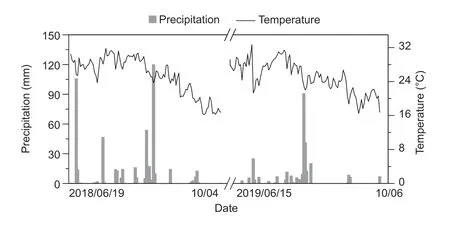
Fig.1 Temperature and precipitation during the growing seasons in 2018 and 2019.
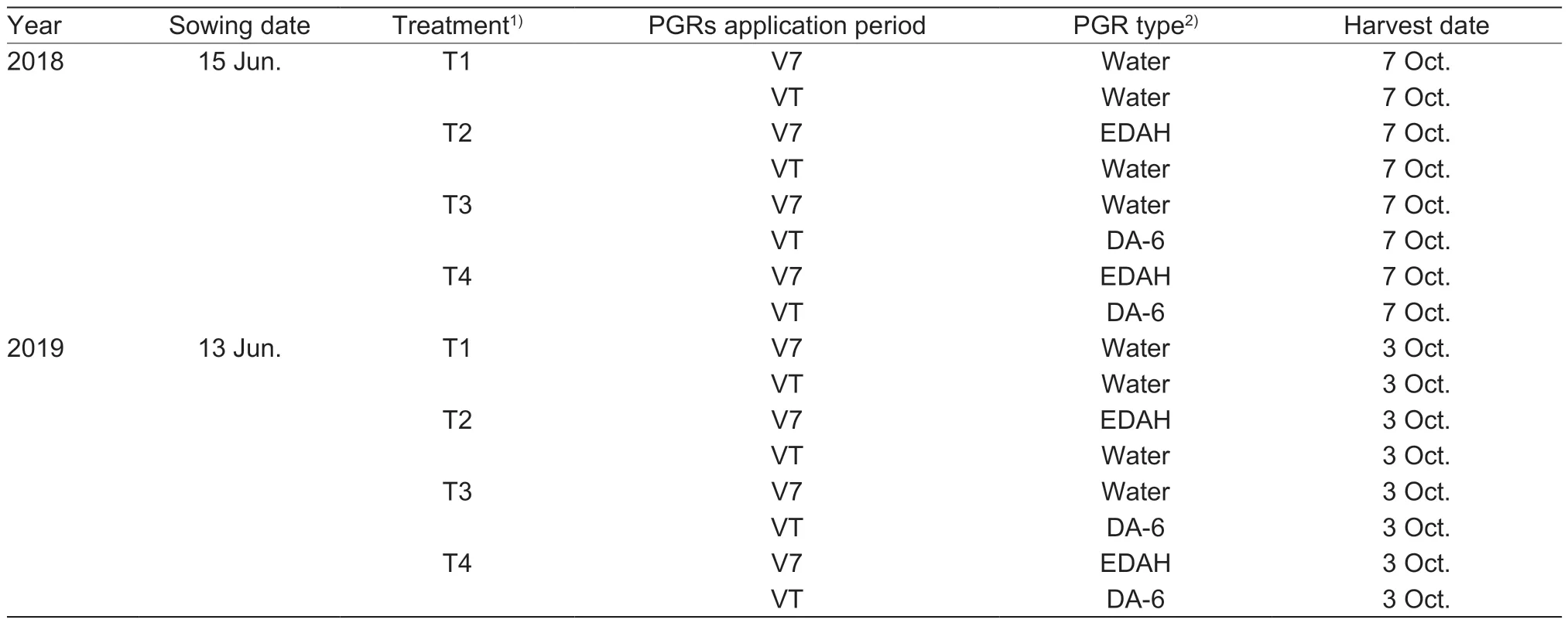
Table 1 Maize sowing,harvest and plant growth regulator (PGR) application dates in this study
Plant height,ear height and center of gravity heightTen days after silking (10 DAS),five maize plants were randomly selected from each plot,and then the maize plants were cut at ground level to measure the center of gravity (the height of the center of gravity was measured from the base to the fulcrum of the balance location). The balance location was determined by an artificial tripod. The plant height and ear height were measured by continuous 20 plants in each plot,the height of plant is the length from the ground to top of the tassel,and the ear height is the length from the ground to the first node bearing an ear.
Maize basal stalk qualityAt 25 DAS,five plants randomly selected in each plot were measured before the basal 8th stalk was cut (e.g.,the stalk between nodes 8 and 9,the 8th stalk),and the 8th stalk length was measured,the stalk length is the length from the lower node to the upper node,and then the crushing strength (CS) and the dry weight(DW) of the basal 8th stalk were measured. The stalk strength tester (Shijiazhuang Shiya Technology Co.,Ltd.,China) was used to measure the CS of the outer skin. The experimenter held firmly stalk and the needle-shaped probe(1 cm long,1-mm2cross-sectional area) was slowly thrust perpendicularly into the stalk until the stop bar touched the stalk. Finally,the stalks were subjected to enzyme deactivation at 105°C for 30 min,followed by drying at 80°C to a constant weight,which was recorded as the dry weight(DW). The dry weight per unit length (DWUL) was calculated according to the following formula:
DWUL (g cm–1)=Weight of stalk/Length of stalk
Stalk structure compoundAt 25 DAS,five maize plants were selected randomly in each plot,and the 8th stalk of each plant was cut out,then the stalks were put into a forceddraft convection oven at 75°C to dry to constant weight and weighted,then crushed with a grinder and sieved (sieve size,0.25 mm). Finally,the cellulose,hemicellulose and lignin content of the samples were determined by the Van-Soest method (Vanet al.1991).
Leaf areaAt 10 DAS,five plants selected randomly in each plot were used to measure the length and width of all leaves with a ruler,the length of the leaves was the length from the tip to the auricle,and the width of the leaves was the widest point.
Leaf senescenceThe ABA content is an important indicator that determines the senescence rate of maize plants. At 25 DAS,0.5 g of maize ear leaf tissue was taken. A total of 4 mL phytohormone extract solution (80% (v/v)methanol extraction medium and 1 mmol L–1butylated hydroxytoluene) were added,and plant fresh tissues in a pre-chilled mortar were ground into a homogenate,transfered to a 10-mL tube placed in 4°C overnight for extraction,and then centrifuged for 15 min (10 000×g,4°C).A total of 1 mL phytohormone extract solution was added to precipitate,and then placed in a refrigerator at 4°C for 1 h.Later it was centrifuged for 15 min (10 000×g,4°C),and the supernatants were combined. The supernatant was blow-dried with N2and then dissolved in 1-mL phosphatebuffered saline (PBS,0.1% (v/v) Tween 20,0.1% (w/v)gelatin (pH 7.5)) for analysis. Three plants were randomly selected in each plot from the silking period every 10 d,and then the length and width of leaves were measured.The leaf area was calculated according to Section 2.3:
Leaf area senescence rate (%)=Leaf area difference/Sampling time difference×100
Mean leaf inclination angle,photosynthetic rate,SPAD,and leaf area indexThe ear row was divided into five measurement points,and mean tilt angle (MTA)was measured using LAI-2200C canopy analyzer (LICor Biosciences,Lincoln,Nebraska,USA),and each measurement point was measured three times. 25 DAS from 10:00 to 12:00 a.m.,the photosynthetic rate (Pn) of maize ear leaves was determined using a photosynthesis instrument (Li-Cor 6400,LI-COR Biosciences,Lincoln,Nebraska,USA),leaf temperature=(30±1)°C,radiation=1 200 μmol m–2s–1. The SPAD-502 chlorophyll meter was used to measure the relative chlorophyll content of plants.
Rubisco enzyme activity in maize ear leaves At 25 DAS,maize ear leaves were harvested in liquid nitrogen,and stored in–80°C refrigerator before measuring rubisco enzyme activity. A total of 0.5-g leaf tissue was weighed into a pre-chilled mortar,and 2 mL buffer (10 μmol DDT,0.5 mmol L–1EDAH,10% glycerol (v/v),and 50 mmol L–1TrisHCL (pH 7.8)) was added to fully grind. The homogenate was centrifuged for 20 min (15 000×g,4°C). Subsequently,the Rubisco enzyme activity was measured according to Wanget al.(2009).
2.4.Statistical analysis
Variance analyses were performed using SPSS 22.0(SPSS Inc.,Chicago,IL,USA). Multiple comparison of different plant grown regulators was tested by LSD test atP<0.05 probability. Figures were performed by Origin 2018(OriginLab Co.,Northampton,MA,USA).
3.Results
3.1.PGRs effect on the maize lodging rate
The maize lodging rate in 2019 was higher than that in 2018,which was caused by the “Super Typhoon Lekima” occurred at maize tasseling stage. PGRs have significant effect on maize lodging rate (Fig.2). Maize plants with T2 and T4 treatments show a significantly low lodging rate compared to the control plants. Maize lodging rate with T2 treatment was reduced by 5.86 and 8.03% in 2018 and 2019,respectively.Lodging rate with T4 treatment was reduced by 6.13 and 7.97% in 2018 and 2019,respectively.
3.2.Morphological characteristics of maize plants and population
As shown in Table 2,PGRs treatments have strongly effect on maize morphological and population characteristics.For these 2-yr field experiments,maize plant height,ear height and the center of gravity height with T2 treatment were reduced by 7.32,15.97 and 10.37%,respectively.After T2 treatment,the upper leaves area (above 13th leaf) and leaf area index (LAI) were reduced by 25.8 and 49.0%,respectively. What’s more,maize LA and LAI with T4 treatment were also reduced by 24.11 and 60.15%,respectively.
Mean tilt angle (MTA) reflects the distribution of maize leaves,and maize with a larger MTA value above ear leaf position shows a more compact canopy structure.Compared with T1 treatment,the MTA values of T2 treatment were significantly (P<0.05) increased by 20.29 and 5.48% in 2018 and 2019,respectively. The values of MTA after T4 treatment significantly (P<0.05) increased by 19.72 and 13.89% compared with T1 in 2018 and 2019,respectively. But,T3 treatment had no obvious effect on the MTA value.
3.3.PGRs improved the quality of the maize 8th stalk
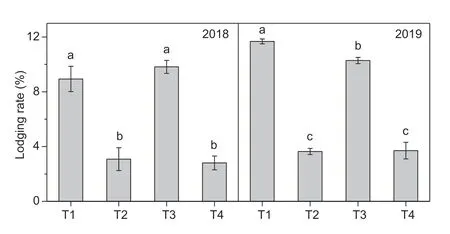
Fig.2 The effect of plant growth regulators (PGRs) on maize lodging rates in 2018–2019. T1,spraying water at V7 (the 7th leaf was fully expanded) and VT (tasseling) stages; T2,spraying EDAH at the V7 stage and water at the VT stage; T3,spraying water at the V7 stage and DA-6 (diethyl aminoethyl hexanoate) at the VT stage; T4,spraying EDAH at the V7 stage and spraying DA-6 at the VT stage. Bars are SD of the means of three measurements. Different letters are significantly different at P<0.05 as determined by the LSD test in different treatments in the same year.

Table 2 Effect of plant growth regulators (PGRs) on maize morphological structure and canopy structure of maize in 2018 and 20191)

Table 3 Effect of plant growth regulators (PGRs) on the quality of maize 8th stalk in 2018 and 20191)
In this study,seven traits were investigated the quality traits of the maize 8th stem (Table 3). It is showed that EDAH has a notably impact on the morphogenesis of the 8th stalk. After T2 and T4 treatments,the length of 8th stalk was shortened by 44.58 and 48.17%,respectively.DWUL of the base stalk is considered to be an important indicator to evaluate maize lodging resistance. After T2 and T4 treatments in 2018,the DWUL increased by 33.33 and 27.78%,respectively; and in 2019,increased by 35.09 and 43.86%. PGRs can significantly (P<0.05) influence maize base stalk crushing strength (CS). In 2018 and 2019,CS with T2 and T4 treatments was increased by 23.13 and 22.23%,respectively,while T3 treatment had no significant effect on CS. In addition,the results showed that hemicellulose,cellulose and lignin contents with T2 treatment were increased by 7.53,5.84 and 27.08%,respectively; and these with T4 treatment were increased by 6.93,3.87 and 30.21%,respectively.
3.4.PGRs improve the photosynthetic rate of maize
PGRs treatments significantly increased maize relative chlorophyll content (SPAD),Pnand Rubisco activity(RA) of maize ear leaf (Table 4). After T2 treatment,the SPAD value,Pnand RA were increased by 7.58,11.32 and 33.77%,respectively. And the SPAD value,Pnand RA with T3 treatment were increased by 6.18,5.29 and 39.16%,respectively. T4 treatment has a better effect on the improvement of maize ear leaf photosynthetic traits,and the specific performance is the SPAD value,PnandRA increased by 11.34,19.32 and 61.39%,respectively.

Table 4 Effect of plant growth regulators (PGRs) on maize relative chlorophyll content (SPAD),net photosynthesis rate (Pn) and Rubisco activity on ear leaf position
3.5.PGRs delayed maize leaf senescence
As shown in Fig.3-A,the senescence rate of leaves is slower at 10–20 DAS; then the senescence rate of maize leaves is more rapid at 20–30 DAS than 10–20 DAS,and the senescence rate of 30–40 DAS maize reached the maximum. PGRs significantly slow down leaves senescence rate. At 30 DAS,the leaf senescence of maize treated with T1,T2 and T3 decreased by 26.85,30.23 and 44.40%,respectively. Compared with T2 and T3 treatments,maize leaf senescence with T4 treatment was delayed by 17.55 and 14.17%,respectively.
At 30 DAS,the ABA content of maize ear leaf has a significant difference after PGRs treatment (Fig.3-B). After T2,T3 and T4 treatments,the content of ABA in maize ear leaves decreased by 26.04,10.62 and 46.47%,respectively.
3.6.PGRs improved maize grain yield
In this study,PGRs treatment increased maize grain yield,but the grain yield change amplitude was different (Table 5).The maize yield of T2,T3 and T4 treatments increased by 3.98,7.60 and 15.51%,respectively,compared with T1.The maize treated with T4 achieved the highest grain yield,which was 1.16×103and 1.17×103kg ha–1higher than T2 and T3 treatments.
The effects of PGRs on maize kernel number per ear were different as the result of year effect. In 2018,maize kernel number per ear with T2,T3 and T4 treatments were reduced by 13.28,6.11 and 6.13%,respectively. But in 2019,T2,T3 and T4 treatments has no obvious effect on maize kernel number per ear. T2,T3 and T4 treatments significantly (P<0.05) affected ear number. Compared with the T1 treatment,ear number with T2,T3 and T4 treatments was increased by 6.10,3.18 and 9.16%,respectively.EDAH in the T2 and T4 treatments increased harvestable ears by reducing maize lodging rates. PGRs treatments had significant effects on maize thousand-kernel weight(TKW). In this 2-yr experiment,maize TKW with T2,T3 and T4 treatments was increased by 5.60,5.57 and 6.37%,respectively.
4.Discussion
Compared with other cultural practices,PGRs can regulate crop growth according to the production demand (Zenget al.2012),which can regulate plant morphology and increase yield by regulating the transmission of plant endogenous hormone signals (Gadallahet al.1999). As we all know,PGRs own the characteristics of low input costs and high benefits,they have been widely used in agricultural production (Dahnouset al.1982). Nowadays,PGRs become an important technical method to guarantee or increase crop yield (Xuet al.2017),improve crop quality(Zhanget al.2014) and enhance crop stress resistance(Naeem and Khan 2012).
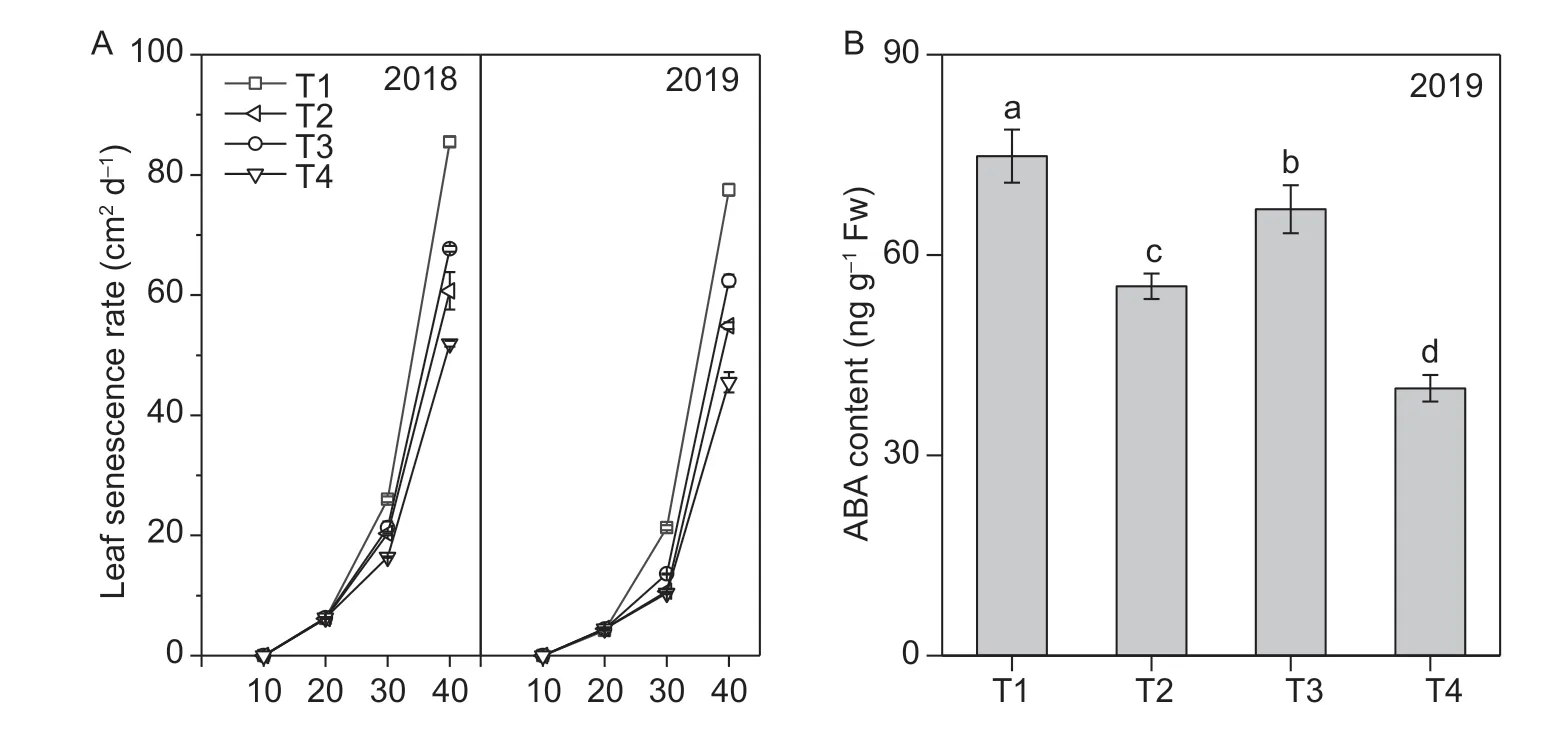
Fig.3 The effect of plant growth regulators (PGRs) on maize aging physiology senescence rate of maize in 2018 and 2019. A,senescence rate of maize in 2018 and 2019. B,abscisic acid (ABA) content of maize in 2019. T1,spraying water at V7 (the 7th leaf was fully expanded) and VT (tasseling) stages; T2,spraying EDAH at the V7 stage and water at the VT stage; T3,spraying water at the V7 stage and DA-6 (diethyl aminoethyl hexanoate) at the VT stage; T4,spraying EDAH at the V7 stage and spraying DA-6 at the VT stage. Bars are standard deviation of the means of three measurements. Different letters upon bars are significantly different at P<0.05 as determined by the LSD test in different treatments in the same year.

Table 5 Effect of plant growth regulators (PGRs) on the grain yield and yield components of maize in 2018 and 2019
In this study,maize grain yield was significantly affected by PGRs. Maize grain yield with T2,T3 and T4 treatments was significantly increased. Above all treatments,T4 treatment had a higher increased extent and stability in maize grain yield. The effect of EDAH on maize grain yield was fluctuated widely,mainly because EDAH had no stable effect on kernel number per ear. In 2018,kernels per ear with EDAH treatment was significantly reduced,but had no significant influence on the kernels number per ear in 2019.Maize grain yield with T3 treatment was increased in this 2-yr experiment,while T3 treatment has a higher lodging rate than T4 treatment,its grain yield is lower than T4(10 953.9vs.11 759.1 kg ha–1). Its effect was not as good as that of EDAH+DA-6 treatment,which may be due to its higher lodging rate (10.10vs.3.23%). According to the production requirements,T4 treatment sprayed EDAH at the V7 stage and DA-6 at VT stage,which adopts the strategy of “control in maize jointing stage,promote in maize filling stage” to increase maize grain yield.
With the increase of maize plant height and ear height,the risk of maize lodging increases significantly (Caiet al.2012).Xu (2017) reported that maize lodging rate had a significant positive correlation with maize plant height,ear height and the center of gravity. After T4 treatment,plant height,ear height and center of gravity of maize were reduced significantly (Table 1),which help to increase maize lodging resistance (Xueet al.2020b). Maize base stalk quality can significantly affect maize lodging resistance (Fenget al.2010; Robertsonet al.2014). The maize plants with higher stalk quality show higher lodging resistance (Thomisonet al.2011; Renet al.2016; Xuet al.2019). The maize stalk with high lodging resistance tends to have shorter length,more structural compounds and better mechanical properties(Zhao 2015; Kamranet al.2018; Rajandeepet al.2020).After EDAH treatment,maize base stalk quality significantly improved. Specifically,the maize base stalk length was shortened,DWUL and CS increased and the proportion of structural increased. Zhanget al.(2012) reported EDAH can improve maize base stalk quality,thereby reducing lodged maize,which is consistent with this experiment. Maize stalks(especially the internode below ear) are prone to breakage during maize growth period (Muhammadet al.2018),causing damage to maize canopy structure and affecting the photosynthesis and transportation of carbohydrates(Wuet al.2014). The compact maize type has a strong lodging resistance,mainly because its canopy structure notably reduced the effect of wind action time and intensity on maize (Liet al.2020). After EDAH treatment,maize LA significantly reduced and MTA significantly increased,which means that maize has a more compact middle and upper canopy structure. The change of maize canopy structure after EDAH treatment contributes to the improvement of maize lodging resistance. In summary,EDAH improves maize lodging resistance by shaping maize plant type and canopy structure and improving maize base stalk quality,and maize lodging rate reduced by 6.95%.
DA-6 has been applied to rice,barley,vegetables,and maize in China (Lianget al.2011). Spraying DA-6 improves the maize grain yield by increasing chlorophyll content and photosynthetic rate (Zhouet al.2004). Compared with CK,maize TKW with DA-6 treatment was increased by 5.97%,indicating that DA-6 significantly increased the maize sink capacity (Liet al.2006). The increase in maize sink capacity facilitates the transfer of carbohydrates to maize ear. Zhao(1981) reported that maize ear leaf contributes the most to the formation of maize grain yield. In this study,after DA-6 treatment,maize photosynthetic performance of ear leaves had been significantly improved. Maize SPAD content,photosynthetic rate and Rubisco enzyme activity with DA-6 treatment were increased,which was conducive to maize produce more photosynthetic products. And DA-6 treatment can prolong the functional period of maize leaves by delaying the senescence rate and reducing ABA content of maize ear leaves. The extension of maize leaves functional stage indicated that maize has a longer time at a highly active stage,which contributes to produce and transport more carbohydrates to ear (Longet al.2001; Gaoet al.2017).
The application of EDAH and DA-6 in different periods can overcome the production barrier caused by EDAH and significantly increased maize grain yield. Spraying EDAH at the jointing stage could significantly reduce maize lodging rate,and spraying DA-6 at the tasseling stage could not only improve maize photosynthetic characters,but also prolong the functional period of maize ear leaves. The application strategy of PGRs used in different crop develop stages(EDAH at the V7 stage and DA-6 at the VT stage) according to the characteristic of PGRs and demand of production can overcome the disadvantage caused by the application of a single PGR (EDAH),and realize a maximize reve.
5.Conclusion
Spraying EDAH at the V7 stage and DA-6 at the VT stage cannot only improve maize lodging resistance,but also promote maize produce more carbohydrates. After EDAH+DA-6 treatment,the maize lodging rate reduced by 6.95%,and the maize grain yield increased by 15.51%.In general,this method of spraying PGRs in the different stages can overcome the instability of EDAH application.This experiment also provides a new application strategy of PGRs for crop production.
Acknowledgements
This work was supported by the National Key Research and Development Program of China (2016YFD0300102-4).
杂志排行
Journal of Integrative Agriculture的其它文章
- Closing crop yield and efficiency gaps for food security and sustainable agriculture
- lmproving winter wheat grain yield and water-/nitrogen-use efficiency by optimizing the micro-sprinkling irrigation amount and nitrogen application rate
- Effects of deep vertical rotary tillage on the grain yield and resource use efficiency of winter wheat in the Huang-Huai-Hai Plain of China
- Effects of mechanized deep placement of nitrogen fertilizer rate and type on rice yield and nitrogen use efficiency in Chuanxi Plain,China
- lmproving grain yield,nitrogen use efficiency and radiation use efficiency by dense planting,with delayed and reduced nitrogen application,in double cropping rice in South China
- Differences of yield and nitrogen use efficiency under different applications of slow release fertilizer in spring maize
